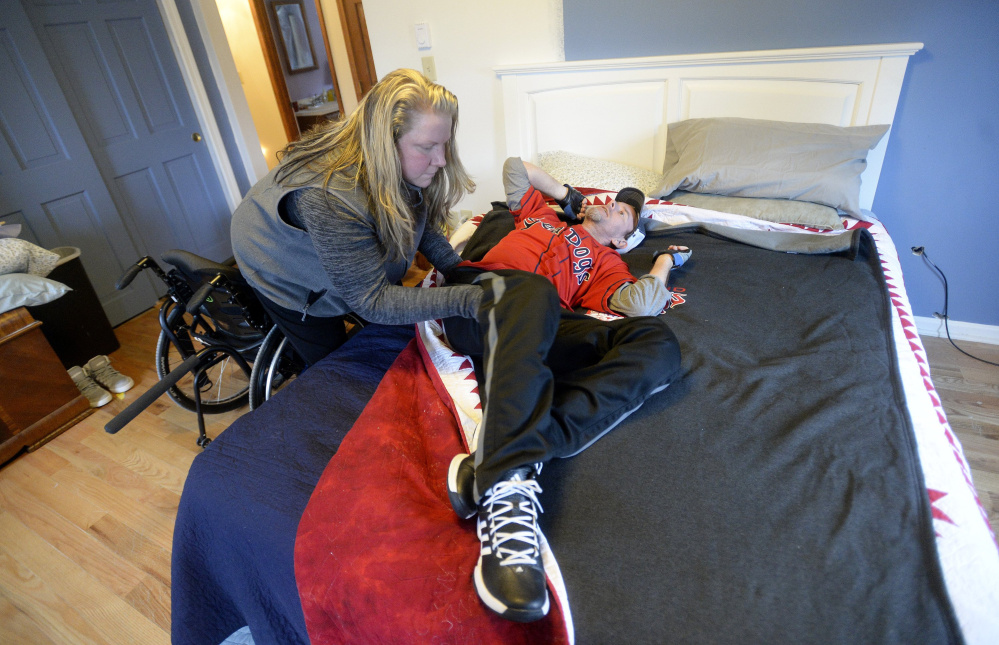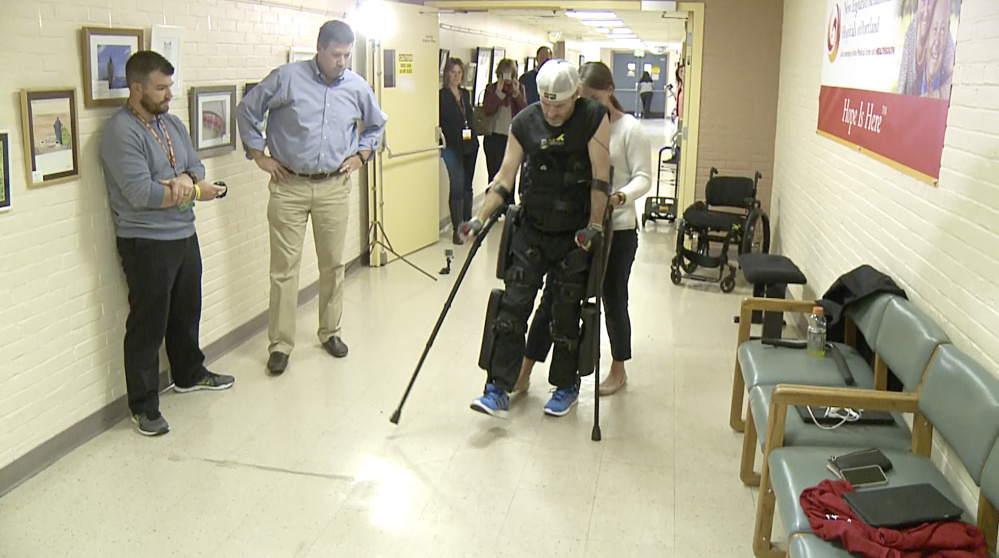Brian Walker sits in a chair at New England Rehabilitation Hospital in Portland as Lauren Peltier checks the small backpack strapped above his waist. He’s wearing a Red Sox cap – brim backward – and a sleeveless T-shirt that shows off his Superman tattoo.
The backpack contains the batteries that power the motorized braces on his legs. Peltier, who works for ReWalk Robotics in Marlborough, Massachusetts, hands him a pair of crutches. Brian, 40, is about to demonstrate the company’s robotic exoskeleton – the “ReWalk” – for the first time in Maine.
“Are you ready?” Peltier asks.
“I’m ready,” Brian says.
A physical therapist standing nearby presses a button on a small wireless remote-control device that looks like a wristwatch. As about a dozen hospital staffers watch, the braces straighten, thrusting Brian into a standing position. After finding his balance, he begins to walk down the brightly lit hallway – 12 months after the accident that left him paralyzed from the chest down.
•••••
It was sunset on Oct. 25, 2014. Brian had just given his 8-year-old son, Nathaniel, a ride on a four-wheeler at his parents’ home in the northern Maine town of Island Falls. Brian’s sister Mary asked if he could take her for a quick spin, too.
Ten minutes later, less than a mile from the house, he hit a tree stump and went flying over the handlebars.
“I remember landing,” Brian says, “and realizing that something was wrong. I couldn’t move my legs, and my sister called out and asked if I was OK, and I said, ‘No, I can’t move.’ ”
Brian’s wife, Carrie, waiting at his parents’ house, was beginning to worry.
“I had a sense something was wrong, because they were supposed to come right back,” she says.
As she headed out the door to look for them, an ambulance pulled into the driveway. She recalls the conversation with the driver vividly:
“Are you Carrie Walker?”
“Yes.”
“You need to come with me.”
“How bad is it?”
“It’s bad.”
A former emergency room nurse, Carrie jumped in the car with her mother-in-law and followed the ambulance.
“At that point, instead of putting on my ‘wife’ hat, I put on my ‘nurse’ hat,” she says. “His mom was sort of getting frantic as we were getting there, and I looked at her and said, ‘You need to remain calm right now.’ ”
They found Brian lying on a backboard waiting for paramedics to arrive.
“(Brian) kept saying, ‘My chest hurts, I feel like I can’t breathe,’ ” Carrie said.
Trying to calm him, she told him he’d be all right. But Brian knew better.
“He looked at me with his big blue eyes that I’ve been looking at for the last 25 years,” she says, “and he said, ‘No, Carrie, I’m not gonna walk.’ ”
•••••
Brian and Carrie met in 1991 at Deering High School, where they were both standout athletes. He played varsity track and soccer, with a vengeance.
“He only knew how to play one way, and that was 100 percent,” says his former coach, Bill Moses. “He was the kid who never quit. If we were down, he was always optimistic we were going to win.”
Carrie noticed his tenacity and can-do attitude right away.
“He’s one of those people: ‘You tell me I can’t and you’d better watch me do it.’ He’s pretty strong-willed.”
It was that strong will that propelled him forward in the dark days after his accident. He knew there was no point in asking, “Why me?”
“I don’t think like that,” he says matter-of-factly.
After two months at Spaulding Rehabilitation Hospital in Boston, Brian came home to what he describes as “the new normal” – and its challenges.
“Not being able to do certain things (is hard) – like mow the lawn or cook or do laundry or just be able to get up quickly and go outside,” he says. “(But) there’s still a lot of things I can do. I had an accident. You just move forward.”
Family and friends raised enough money to put a handicap-accessible addition on the Walkers’ Portland home, and he’s been able to resume his job working from home as an account manager for a medical supply company.
His close friend Greg Violette says it didn’t take Brian long to come to terms with his disability.
“I feel like right after the accident he just sort of accepted it,” Violette says, “and figured out how he was going to rearrange his life to be a good husband and a good dad.”
Brett Plymale, who’s known Brian since the third grade, agrees.
“He’s the same guy I’ve known all this time,” Plymale says, “the guy who says, ‘I can do this.’ ”
The guy who won’t let go of hope.
“He never once had a doubt in his mind,” Carrie says, “that in some way, shape or form he would be up and about moving his body again.”
•••••
Brian first heard about the high-tech device that would get him back on his feet from physical therapist Andrea Corio at Spaulding Rehabilitation.
“She was like, ‘I’m gonna get you in that thing,’ and I said, ‘Well, yeah, we are gonna get in that thing.’ ”
“That thing” is called a ReWalk – a wearable robotic exoskeleton that powers the knees and hips to enable a person with a spinal cord injury to stand and move. The battery-powered system, controlled by a small computer, senses shifts in movement and automatically adjusts the leg braces to mimic a natural gait.
A remote-control device that fits on the wrist, called a communicator, sends signals to the computer via radio frequency. There are four settings: stand, walk, sit and manual, which allows the user to extend the knee joints while seated.
In June 2014, the company became the first to be given clearance by the U.S. Food and Drug Administration to market a robotic exoskeleton to consumers. Thirty-two ReWalk systems – which cost $77,000 apiece – have been sold in the United States in the past year for personal use, and 39 rehabilitation centers own ReWalks for patient use. At another 25 centers, including New England Rehabilitation Hospital, physical therapists have been trained in using the technology.
Because the technology is so new, ReWalks are covered by insurance on a case-by-case basis. Individuals are usually asked to submit as much information as possible to their carriers, including physical therapy evaluations and progress notes, a letter of medical necessity, and sometimes even video of the person using the ReWalk system. Of the 32 units sold in this country since last year, insurance covered 14.
Until he can afford to buy one or persuade his insurance company to cover it, Brian uses the ReWalk only in a clinical setting. But even that’s a big step forward.
“It’s amazing that someone who has been unable to stand and walk is now able to walk … and be upright again,” says physical therapist Laura Young, who watched Brian’s trek down the hallway at New England Rehab Hospital.
Being upright provides critical health benefits for people with spinal cord injuries, says Scott Reeves, ReWalk Robotics’ business development manager for the Northeast.
“There’s a lot of medical benefits from standing,” Reeves says, “from weight bearing, improved circulation, flexibility, tone and the potential for decreased urinary tract infections and pressure sores. The secondary complications from spinal cord injuries are the biggest issues that a lot of these people face.”
•••••
Brian, once an expert skier, quickly got the hang of it after first experimenting with the ReWalk at Spaulding in September.
“Almost immediately I had the balance thing figured out. I thought about the skiing aspect, because you have to use the crutches, and a lot of the balancing was the same as how you would balance skiing.”
As he takes the last few steps down the hallway and sits in his wheelchair, the crowd watching the demonstration bursts into applause.
“I did it,” he says, smiling.
And how did it feel?
“It just felt like normal again,” he says.
The same way it felt when, for the first time in a year, Brian was able to stand eye to eye with Carrie and hold her in his arms.
“That was one of the most beautiful things,” she says. “(For that moment) we were back where we were before this happened.”
Send questions/comments to the editors.




Comments are no longer available on this story